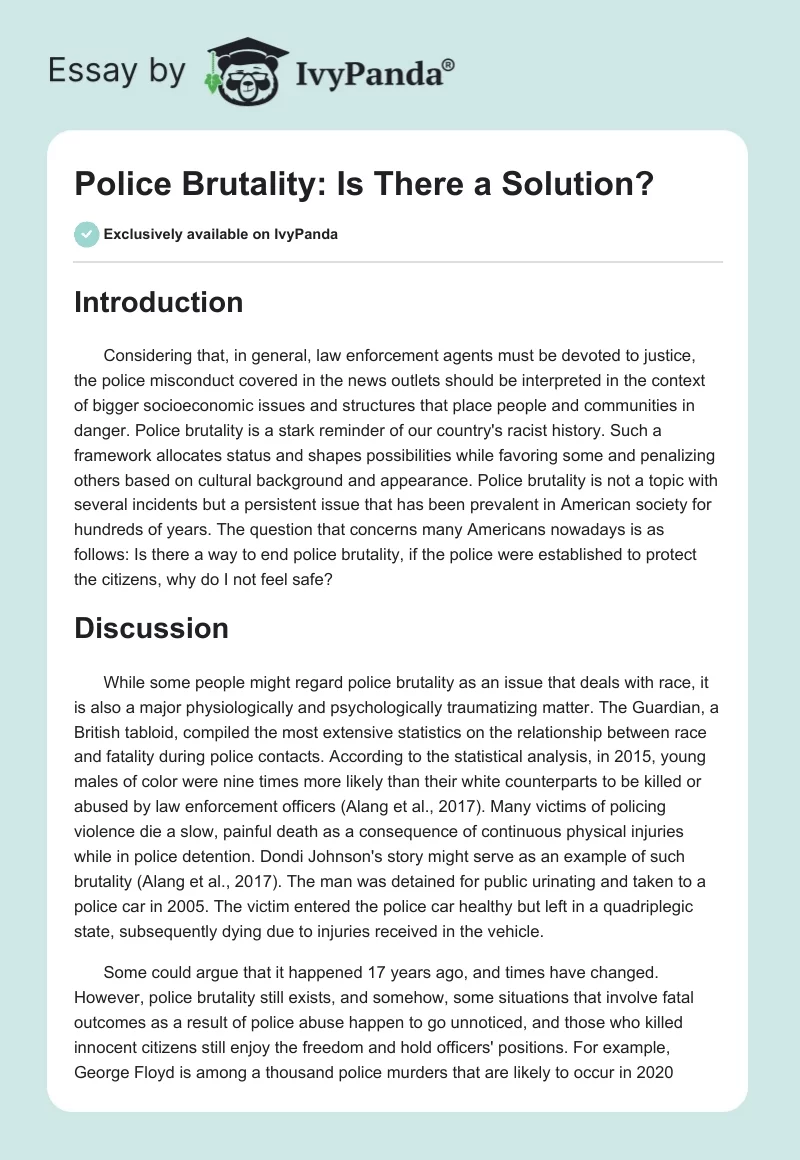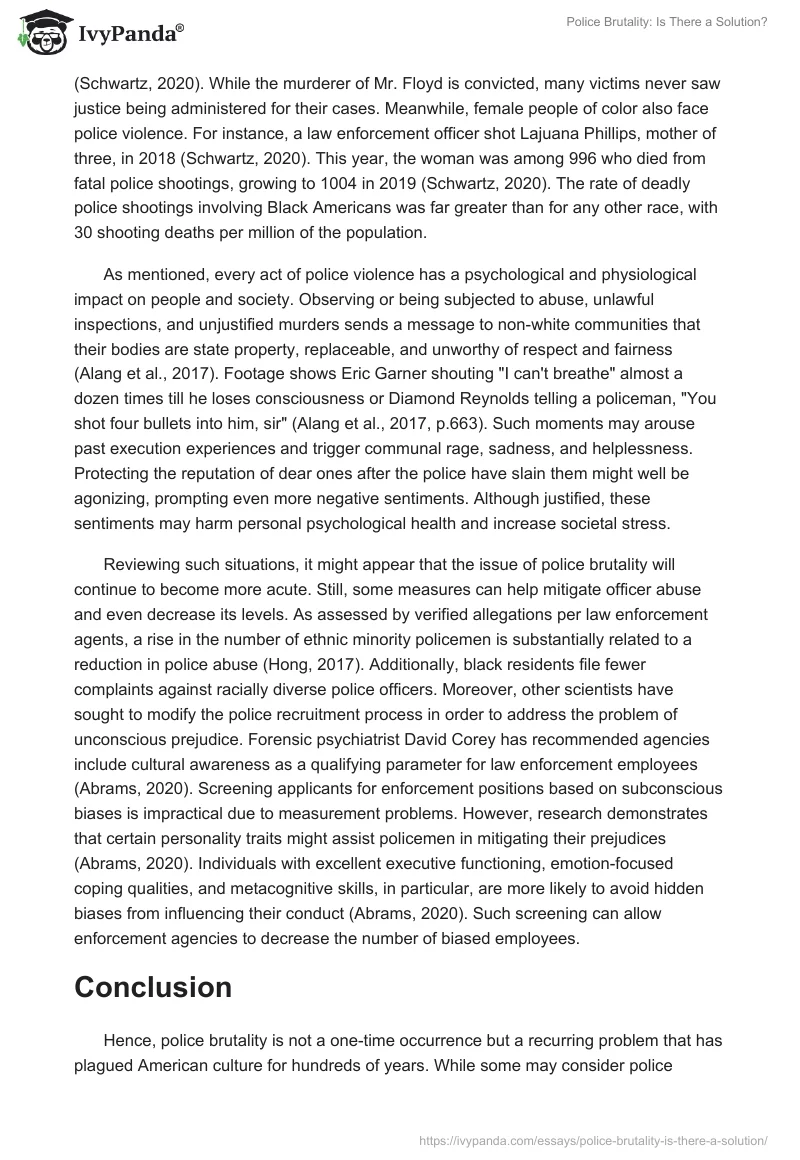Introduction
Considering that, in general, law enforcement agents must be devoted to justice, the police misconduct covered in the news outlets should be interpreted in the context of bigger socioeconomic issues and structures that place people and communities in danger. Police brutality is a stark reminder of our country’s racist history. Such a framework allocates status and shapes possibilities while favoring some and penalizing others based on cultural background and appearance. Police brutality is not a topic with several incidents but a persistent issue that has been prevalent in American society for hundreds of years. The question that concerns many Americans nowadays is as follows: Is there a way to end police brutality, if the police were established to protect the citizens, why do I not feel safe?
Discussion
While some people might regard police brutality as an issue that deals with race, it is also a major physiologically and psychologically traumatizing matter. The Guardian, a British tabloid, compiled the most extensive statistics on the relationship between race and fatality during police contacts. According to the statistical analysis, in 2015, young males of color were nine times more likely than their white counterparts to be killed or abused by law enforcement officers (Alang et al., 2017). Many victims of policing violence die a slow, painful death as a consequence of continuous physical injuries while in police detention. Dondi Johnson’s story might serve as an example of such brutality (Alang et al., 2017). The man was detained for public urinating and taken to a police car in 2005. The victim entered the police car healthy but left in a quadriplegic state, subsequently dying due to injuries received in the vehicle.
Some could argue that it happened 17 years ago, and times have changed. However, police brutality still exists, and somehow, some situations that involve fatal outcomes as a result of police abuse happen to go unnoticed, and those who killed innocent citizens still enjoy the freedom and hold officers’ positions. For example, George Floyd is among a thousand police murders that are likely to occur in 2020 (Schwartz, 2020). While the murderer of Mr. Floyd is convicted, many victims never saw justice being administered for their cases. Meanwhile, female people of color also face police violence. For instance, a law enforcement officer shot Lajuana Phillips, mother of three, in 2018 (Schwartz, 2020). This year, the woman was among 996 who died from fatal police shootings, growing to 1004 in 2019 (Schwartz, 2020). The rate of deadly police shootings involving Black Americans was far greater than for any other race, with 30 shooting deaths per million of the population.
As mentioned, every act of police violence has a psychological and physiological impact on people and society. Observing or being subjected to abuse, unlawful inspections, and unjustified murders sends a message to non-white communities that their bodies are state property, replaceable, and unworthy of respect and fairness (Alang et al., 2017). Footage shows Eric Garner shouting “I can’t breathe” almost a dozen times till he loses consciousness or Diamond Reynolds telling a policeman, “You shot four bullets into him, sir” (Alang et al., 2017, p.663). Such moments may arouse past execution experiences and trigger communal rage, sadness, and helplessness. Protecting the reputation of dear ones after the police have slain them might well be agonizing, prompting even more negative sentiments. Although justified, these sentiments may harm personal psychological health and increase societal stress.
Reviewing such situations, it might appear that the issue of police brutality will continue to become more acute. Still, some measures can help mitigate officer abuse and even decrease its levels. As assessed by verified allegations per law enforcement agents, a rise in the number of ethnic minority policemen is substantially related to a reduction in police abuse (Hong, 2017). Additionally, black residents file fewer complaints against racially diverse police officers. Moreover, other scientists have sought to modify the police recruitment process in order to address the problem of unconscious prejudice. Forensic psychiatrist David Corey has recommended agencies include cultural awareness as a qualifying parameter for law enforcement employees (Abrams, 2020). Screening applicants for enforcement positions based on subconscious biases is impractical due to measurement problems. However, research demonstrates that certain personality traits might assist policemen in mitigating their prejudices (Abrams, 2020). Individuals with excellent executive functioning, emotion-focused coping qualities, and metacognitive skills, in particular, are more likely to avoid hidden biases from influencing their conduct (Abrams, 2020). Such screening can allow enforcement agencies to decrease the number of biased employees.
Conclusion
Hence, police brutality is not a one-time occurrence but a recurring problem that has plagued American culture for hundreds of years. While some may consider police brutality to be a racial issue, it is also a huge physiological and psychologically damaging matter. Many victims of police brutality die slowly and painfully due to ongoing physical injuries while in police custody. Police brutality not only exists, but certain incidents with deadly results go unacknowledged, and officers who killed innocent persons continue to enjoy freedom and occupy positions of authority. Some steps, such as screening law enforcement applicants for prejudice and hiring more people from diverse cultural backgrounds, can help attenuate and even reduce police abuse.
References
Abrams, Z. (2020). What works to reduce police brutality. American Psychology Association, 51(7). Web.
Alang, S., McAlpine, D., McCreedy, E., & Hardeman, R. (2017). Police brutality and black health: Setting the agenda for public health scholars. American Journal of Public Health, 107(5), 662-665. Web.
Hong, S. (2017). Does increasing ethnic representativeness reduce police misconduct?Public Administration Review, 77(2), 195-205. Web.
Schwartz, S. A. (2020). Police brutality and racism in America. Explore, 16(5), 280. Web.


